Shopping Cart
- Remove All
 Your shopping cart is currently empty
Your shopping cart is currently empty
Anti-NANOG Polyclonal Antibody 2 is a Rabbit antibody targeting NANOG. Anti-NANOG Polyclonal Antibody 2 can be used in IF,IHC-Fr,IHC-P,WB.
| Pack Size | Price | Availability | Quantity |
|---|---|---|---|
| 50 μL | $220 | 7-10 days | |
| 100 μL | $373 | 7-10 days | |
| 200 μL | $528 | 7-10 days |
| Description | Anti-NANOG Polyclonal Antibody 2 is a Rabbit antibody targeting NANOG. Anti-NANOG Polyclonal Antibody 2 can be used in IF,IHC-Fr,IHC-P,WB. |
| Ig Type | IgG |
| Reactivity | Human,Mouse,Rat |
| Verified Activity | 1. Sample: A431 (Human) Cell Lysate at 30 μg Primary: Anti-Nanog (TMAB-01202) at 1/300 dilution Secondary: IRDye800CW Goat Anti-Rabbit IgG at 1/20000 dilution Predicted band size: 34 kDa Observed band size: 34 kDa 2. Sample: NIH/3T3 (Mouse) Cell Lysate at 30 μg Primary: Anti-Nanog (TMAB-01202) at 1/300 dilution Secondary: IRDye800CW Goat Anti-Rabbit IgG at 1/20000 dilution Predicted band size: 34 kDa Observed band size: 34 kDa 3. Paraformaldehyde-fixed, paraffin embedded (Mouse ovary); Antigen retrieval by boiling in sodium citrate buffer (pH6.0) for 15 min; Block endogenous peroxidase by 3% hydrogen peroxide for 20 min; Blocking buffer (normal goat serum) at 37°C for 30 min; Antibody incubation with (Nanog) Polyclonal Antibody, Unconjugated (TMAB-01202) at 1:400 overnight at 4°C, followed by a conjugated Goat Anti-Rabbit IgG antibody for 90 minutes, and DAPI for nucleus staining. 4. Tissue/cell: rat testis tissue; 4% Paraformaldehyde-fixed and paraffin-embedded; Antigen retrieval: citrate buffer (0.01M, pH6.0), Boiling bathing for 15 min; Block endogenous peroxidase by 3% Hydrogen peroxide for 30 min; Blocking buffer (normal goat serum) at 37°C for 20 min; Incubation: Anti-Nanog Polyclonal Antibody, Unconjugated (TMAB-01202) 1:200, overnight at 4°C, followed by conjugation to the secondary antibody and DAb staining. 5. Paraformaldehyde-fixed, paraffin embedded (Mouse ovarian); Antigen retrieval by boiling in sodium citrate buffer (pH6.0) for 15 min; Block endogenous peroxidase by 3% hydrogen peroxide for 20 min; Blocking buffer (normal goat serum) at 37°C for 30 min; Antibody incubation with (Nanog) Polyclonal Antibody, Unconjugated (TMAB-01202) at 1:400 overnight at 4°C, followed by operating according to SP Kit (Rabbit) instructionsand DAB staining. 6. Tissue/cell: rat testis tissue; 4% Paraformaldehyde-fixed and paraffin-embedded; Antigen retrieval: citrate buffer (0.01M, pH6.0), Boiling bathing for 15 min; Block endogenous peroxidase by 3% Hydrogen peroxide for 30 min; Blocking buffer (normal goat serum) at 37°C for 20 min; Incubation: Anti-Nanog Polyclonal Antibody, Unconjugated (TMAB-01202) 1:200, overnight at 4°C, followed by conjugation to the secondary antibody and DAb staining. 7. Tissue/cell: mouse embryo tissue; 4% Paraformaldehyde-fixed and paraffin-embedded; Antigen retrieval: citrate buffer (0.01M, pH6.0), Boiling bathing for 15 min; Block endogenous peroxidase by 3% Hydrogen peroxide for 30 min; Blocking buffer (normal goat serum) at 37°C for 20 min; Incubation: Anti-Nanog Polyclonal Antibody, Unconjugated (TMAB-01202) 1:200, overnight at 4°C, followed by conjugation to the secondary antibody and DAb staining. 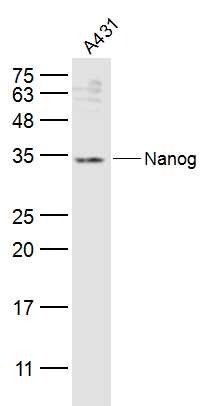 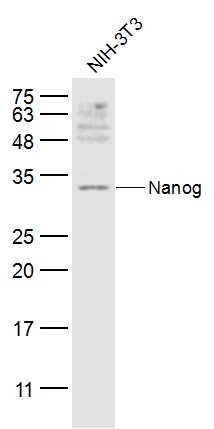 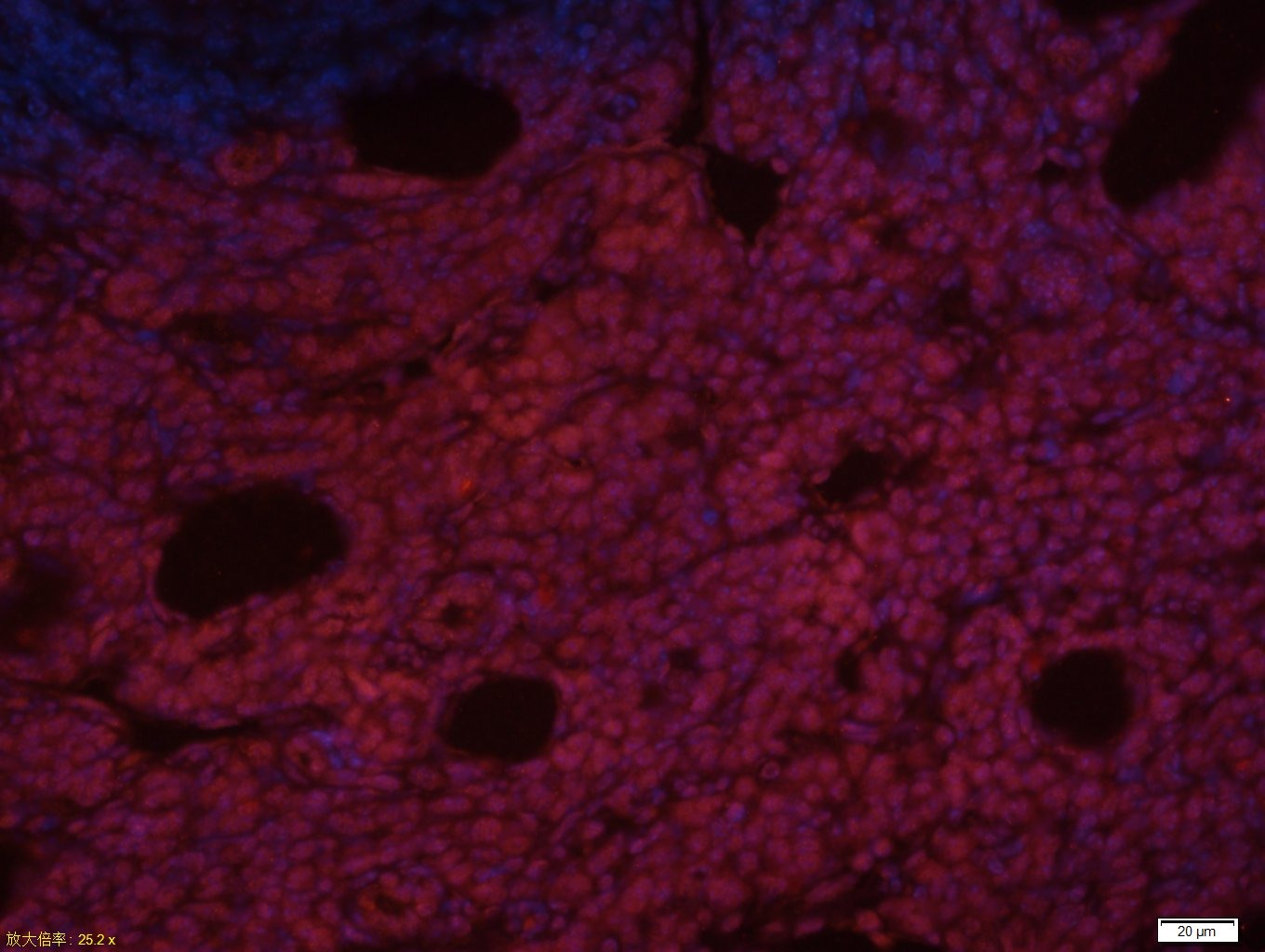 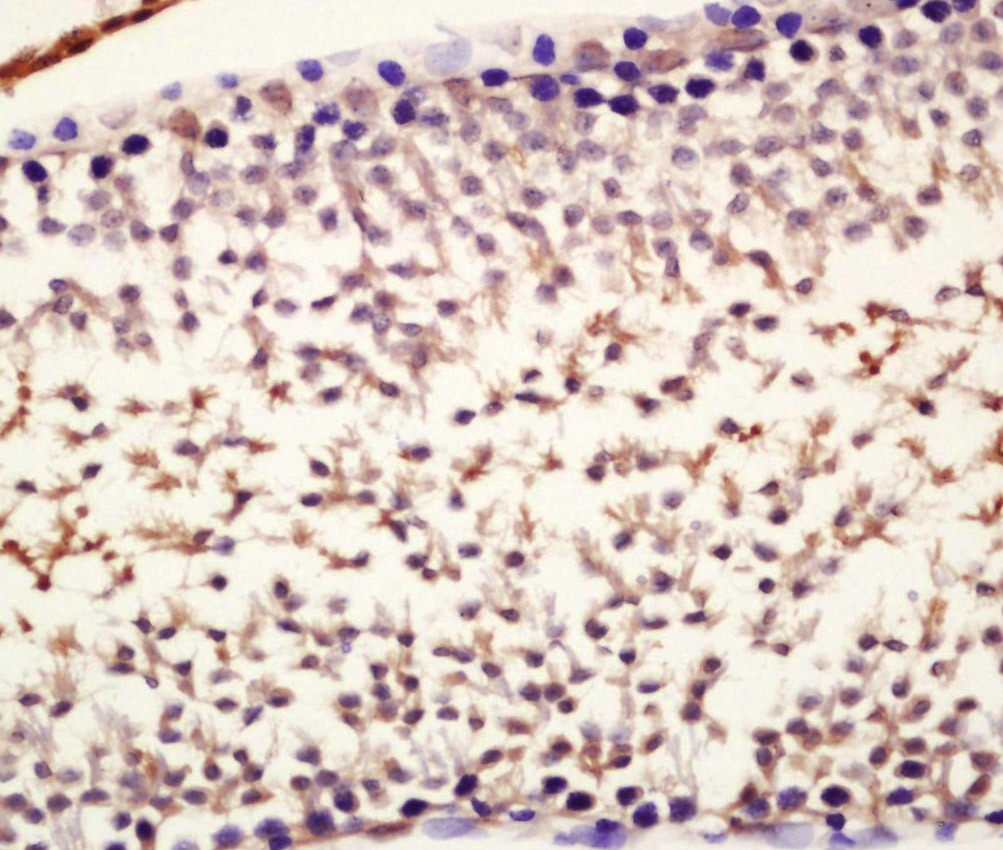  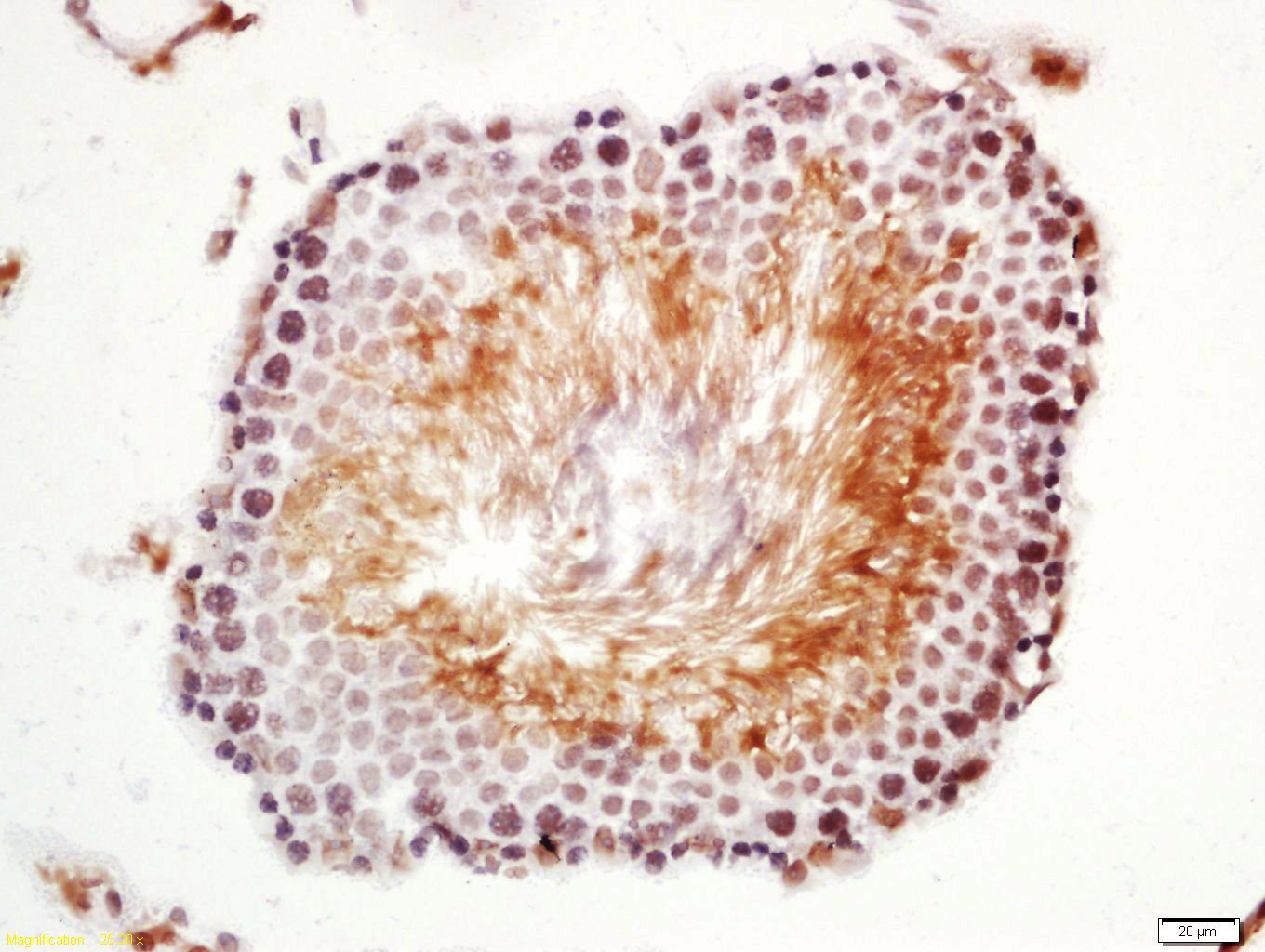 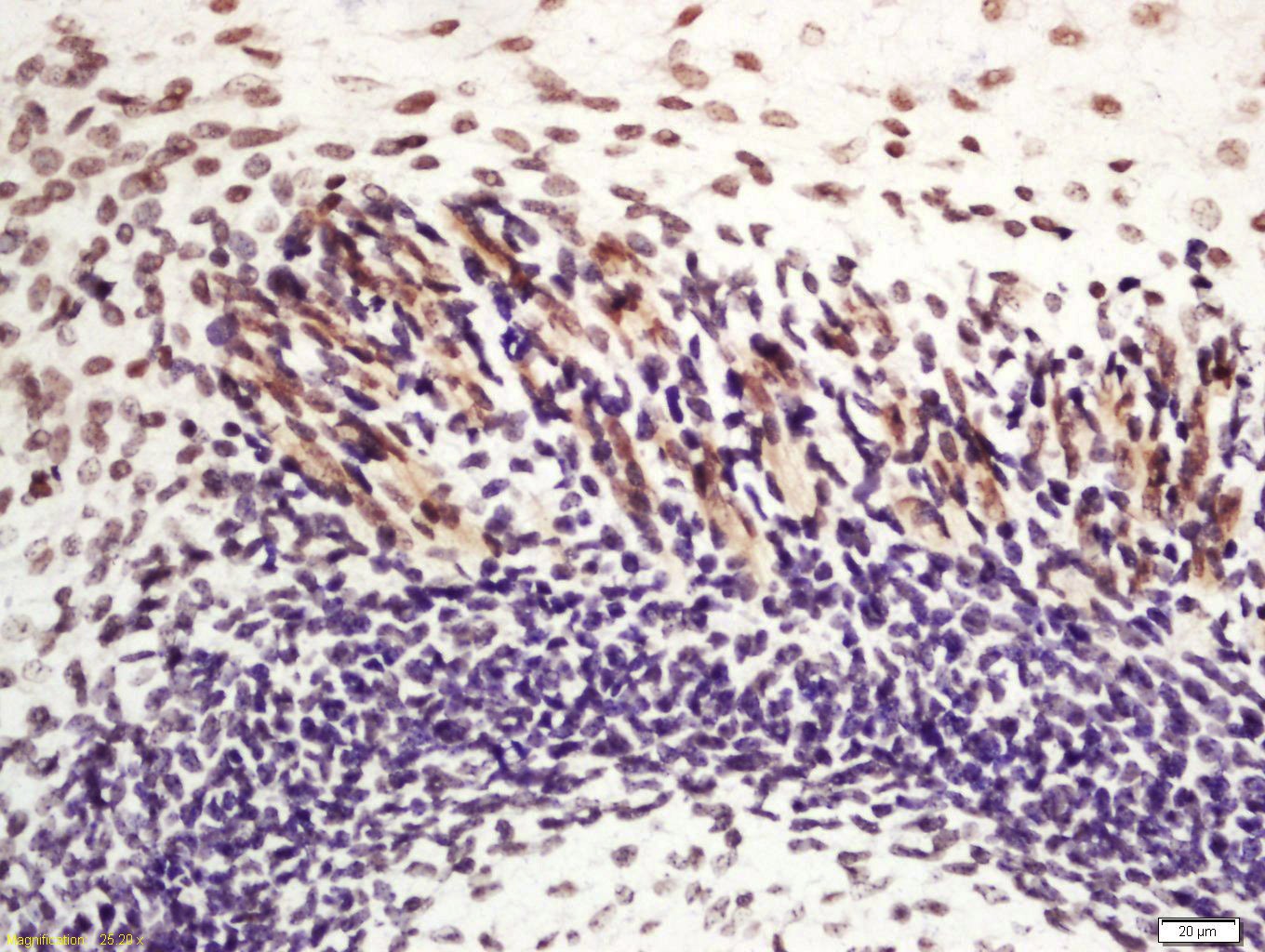 |
| Application | |
| Recommended Dose | WB: 1:500-2000; IHC-P: 1:100-500; IHC-Fr: 1:100-500; IF: 1:100-500 |
| Antibody Type | Polyclonal |
| Host Species | Rabbit |
| Subcellular Localization | Nucleus. |
| Tissue Specificity | Expressed in testicular carcinoma and derived germ cell tumors (at protein level). Expressed in fetal gonads, ovary and testis. Also expressed in ovary teratocarcinoma cell line and testicular embryonic carcinoma. Not expressed in many somatic organs and |
| Construction | Polyclonal Antibody |
| Purification | Protein A purified |
| Appearance | Liquid |
| Formulation | 0.01M TBS (pH7.4) with 1% BSA, 0.02% Proclin300 and 50% Glycerol. |
| Concentration | 1 mg/mL |
| Research Background | Nanog is a newly identified homeodomain-bearing transcriptional factor. Nanog expression is specific to early embryos and pluripotential stem cells including mouse and human embryonic stem (ES) and embryonic germ (EG) cells. It is a key molecule involved in the signaling pathway for maintaining the capacity for self-renewal and pluripotency, bypassing regulation by the STAT3 pathway. Nanog mRNA is present in pluripotent mouse and human cell lines, and absent from differentiated cells. Nanog-deficient ES cells lose pluripotency and differentiate into extraembryonic endoderm lineage. Thus it is one of the molecular markers suitable for recognizing the undifferentiated state of stem cells in the mouse and human. NANOG is a new marker for testicular carcinoma in situ and germ cell tumors. NANOG is a gene expressed in embryonic stem cells (ESCs) and is thought to be a key factor in maintaining pluripotency. NANOG thought to function in concert with other factors such as POU5F1 and SOX2 to establish ESC identity. These cells offer an important area of study because of their ability to maintain pluripotency. In other words, these cells have the ability to become virtually any cell of any of the three germ layers (endoderm, ectoderm, mesoderm). |
| Immunogen | KLH conjugated synthetic peptide: mouse Nanog |
| Antigen Species | Mouse |
| Gene Name | NANOG |
| Gene ID | |
| Protein Name | Homeobox protein NANOG |
| Biology Area | Cell differentiation,Surface molecules,SMADs,Transcription Factors,Intracellular |
| Function | Transcription regulator involved in inner cell mass and embryonic stem (ES) cells proliferation and self-renewal. Imposes pluripotency on ES cells and prevents their differentiation towards extraembryonic endoderm and trophectoderm lineages. Blocks bone morphogenetic protein-induced mesoderm differentiation of ES cells by physically interacting with SMAD1 and interfering with the recruitment of coactivators to the active SMAD transcriptional complexes. Acts as a transcriptional activator or repressor. Binds optimally to the DNA consensus sequence 5'-TAAT[GT][GT]-3' or 5'-[CG][GA][CG]C[GC]ATTAN[GC]-3'. When overexpressed, promotes cells to enter into S phase and proliferation. |
| Molecular Weight | Theoretical: 34 kDa. |
| Stability & Storage | Store at -20°C or -80°C for 12 months. Avoid repeated freeze-thaw cycles. |
| Transport | Shipping with blue ice. |

Copyright © 2015-2025 TargetMol Chemicals Inc. All Rights Reserved.